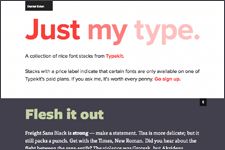PT Sans Regular
Designed by Alexandra Korolkova, Olga Umpeleva and Vladimir Yefimov. Released by ParaType in 2009. PT Sans is a modern humanist sans serif font. Imperfect bowls, slightly tapered spurs, a tear-drop shaped counterform on the g, and a soft foot terminal on the l all make PT Sans feel slightly more hand-written than manufactured. It has […]
Continue Reading








